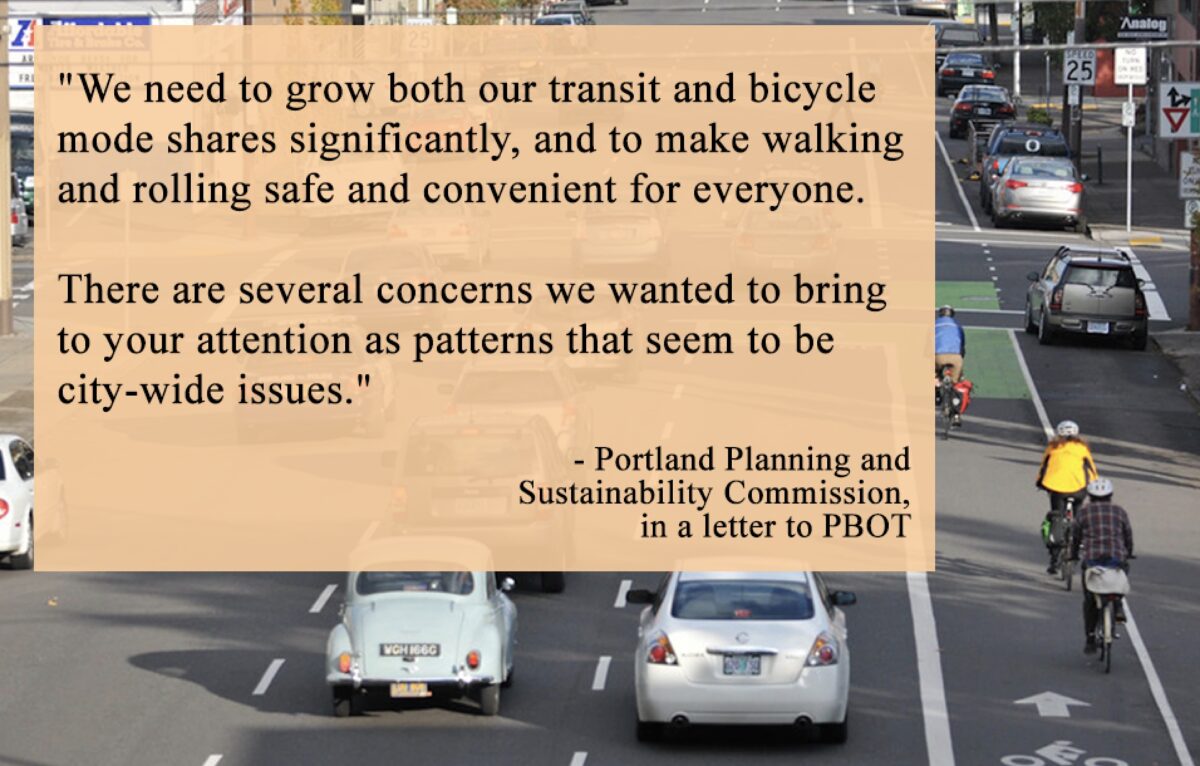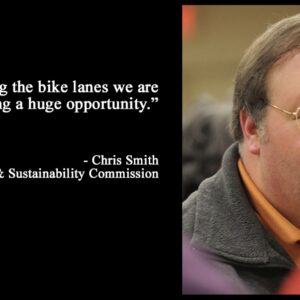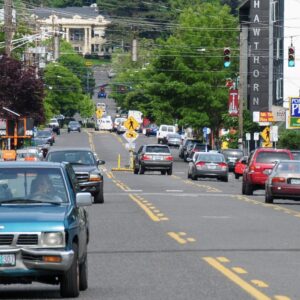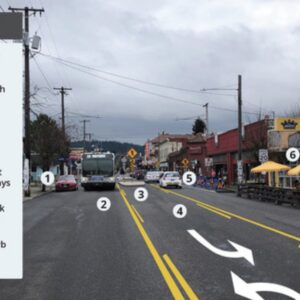The body that oversees Portland’s Comprehensive Plan, Climate Action Plan and zoning code had planned to strongly question the City of Portland’s recent decision to not stripe bike lanes on Southeast Hawthorne Boulevard.
But late last month, when some members of the Portland Planning and Sustainability Commission balked at getting enmeshed in a debate about the controversial Hawthorne Pave and Paint Project decision and expressed concern that it was out of their purview, they (mostly all) agreed to change the focus of the letter.
That letter (PDF) is now finalized and was sent to Portland Bureau of Transportation Director Chris Warner yesterday (3/8). It voices concerns over rising emissions, falling bike usage rates, and a “pattern” of project decisions that aren’t doing enough to reduce car use.
Signed by PSC Chair Eli Spevak, owner of housing development company Orange Splot LLC, the letter avoids direct criticism of the Hawthorne decision (something several PSC members were not comfortable with). Instead it refers to Hawthorne tangentially and says, “As custodians of both the Transportation Systems Plan (TSP) and the Climate Action Plan, we are keenly interested in how these projects get carried out, as they affect our ability to achieve our transportation and climate goals.”
Advertisement
“As you know, to meet our goals for people movement, access to economic opportunity and climate we need to grow both our transit and bicycle mode shares significantly, and to make walking and rolling safe and convenient for everyone.”
Then the letter refers to “several concerns” over “patterns that seem to be city-wide issues.”
While the references are veiled, this letter seems notable because it was clearly spurred by a PBOT decision to maintain space for driving cars on a major commercial street (even after hearing lots of support for less of it) and it makes references to “how these projects get carried out” while it shares concerns about “patterns” of higher emissions and lower bike mode share.
Among the trends highlighted by the letter are rising emissions from the transportation sector in Multnomah County, rising auto congestion, and a decline in bicycle mode share since the adoption of the Bicycle Master Plan in 2010 (and that current levels are, “a long way from our 25% goal”).
Advertisement
The letter also reminds Director Warner that “Direct access to destinations is a key strategy of the bicycle master plan,” and that Comprehensive Plan Policy 9.20 states that Portland should, “Create conditions that make bicycling more attractive than driving for most trips of approximately three miles or less.” This seems like a direct reference to PBOT’s tendency to push bicycle users to shared back streets rather than creating space for them commercial streets.
The PSC further underscored the urgency to reduce driving by citing the Pedestrian Master Plan which states, “A large part of improving pedestrian safety outcomes in Portland will lie with reducing the number of people driving, and facilitating and encouraging more Portlanders to walk, bike, and take transit.”
The letter invites PBOT to engage the PSC on how transportation can fit into their portfolio. “We look forward to continuing to work together to make our bicycle network responsive to our land use patterns and achieving our [Transportation System Plan] goals,” reads the last line.
This letter comes as PBOT’s own Bicycle Advisory Committee plans to discuss their “profound disappointment” in the Hawthorne decision at their meeting tonight (3/9).
— Jonathan Maus: (503) 706-8804, @jonathan_maus on Twitter and jonathan@bikeportland.org
— Get our headlines delivered to your inbox.
— Support this independent community media outlet with a one-time contribution or monthly subscription.







Thanks for reading.
BikePortland has served this community with independent community journalism since 2005. We rely on subscriptions from readers like you to survive. Your financial support is vital in keeping this valuable resource alive and well.
Please subscribe today to strengthen and expand our work.
It’s disappointing that Hawthorne is the project that caused this. PBOT has been doing this for years without much reproach.
When we do build on arterial roads, we need to build platinum+ bike infrastructure. Hawthorne should have raised bike lanes and expanded sidewalks. That’s not going to happen any time soon, but it needs to happen.
Portland needs to focus on making it easier to bike, not harder to drive. The low hanging fruit here is obviously the greenways. If Portland had the courage to make sure our greenways were actually green by installing traffic diverters at regular intervals, we’d have the best bike network in the country in a year or two. Bike lanes just don’t appeal to most casual riders.
Focus on greenways to expand our biking culture while we take on the slower and more expensive task of building platinum level bike infrastructure on arterial roads, but also, let’s stop pretending paint is protection or even worth wasting on the road. No more plastic wands, paint buffers, or unprotected bike lanes. Quality or nothing should be the demand because every time PBOT or ODOT builds some garbage, the public thinks cyclist are being catered to so we are spending our social capital. We are spending our good will on projects that make no meaningful different to the mobility of bikes.
cmh89, lots of points so I’ll just briefly point at one. Coming from E Portland there is little I would like to see more than PBLs on 122nd. But I, and most people, travel into the center of Portland. Draw a line through Portland and you have a commuter route. Hawthorne is the perfect place to start that network. I think advocates from all over Portland are finally realizing this: when we design a safe and separated network in inner SE, it affects every neighborhood, not just inner SE.
Is there a tunnel through Mt Tabor from East Portland to Hawthorne Blvd that I don’t know about? Because that’s what it looks like if I draw a line through Portland as you suggest.
Hawthorne > 50th > Lincoln (and eventually, Division)
Hawthorne > Ladd > Harrison-Lincoln is a shorter path because of the diagonal Ladd Ave. This idea that it would have been a good commuter route from East Portland really doesn’t make sense. The greenway is not only a more direct route, but greenways typically have less delay than a busy street because there are fewer traffic signals. I get the argument for access to businesses, but it wouldn’t have been very useful as a long-distance commuter route.
The biggest predictor of modal share in any city is a network of separated bike lanes. PBoT has invested in greenways for a decade with a modal share decrease from 8% to 5% and an increase in fatalities to a record since 1996. If you want to change the modal share, greenways aren’t going to do it. Period.
Long distance cycletracks on commercial streets are much faster, safer and directly connect neighborhood hubs when designed correctly. My hope is that somehow the BAC or other advocacy groups finally adopt “spokes” or corridors to focus on building separate infrastructure, (eg Hawthorne, 50th/52nd as a couplet, Foster to Lents).
I completely agree, and want to build on what you said: Where PBOT has built protected bike lanes, they are almost all opportunistic and isolated segments. An isolated segment does very little to help build a useful network, regardless of how “safe” it is. PBOT really needs to focus on making strong, direct, simple and safe connections between routes.
I would really love for advocacy groups (eg street trust, bikeloud etc) to recognize this central idea, and advocate for “corridors” or “spokes”. At present PBoT seems to use the dartboard approach to improving streets. I don’t believe this excludes E Portland (I wouldn’t be here if it did and PBLs on 122nd should very much be at the top of the list), but any modal share increase inevitably involves a simple fully separated network in the central city.
I much prefer greenways to any kind of bike lane, if they’re greenways without much car traffic. That means they need frequent, functional diversion. Drivers need to know they’ll damage their cars if they disregard or crash into a diverter.
No more mountable curbs.
I think a lot of people would agree mh, primarily because we don’t have well-designed, low-stress separated bike lanes, and people in Portland haven’t really been exposed to them.
The Harrison-Lincoln-Harrison portion of the NG is a decent route to Mt. Tabor but from that point on elevation gain become a barrier to most who are not “bike enthusiasts” or very fit.
The sub par bike lane on Division and newly improved SE Clinton-Woodward see heavier use for transportation purposes, IMO.
I actually think arterial roads like Hawthorne are terrible for bike commuting. The things that we value on roads like Hawthorne or Rosa Parks to slow down cars such as stop signs/lights and speed bumps inhibit biking.
Long-distance biking should take place on greenways with no stop signs and as few traffic lights as possible with traffic diverters frequent along the route. PBL should exist on streets like Hawthorne to provide short-distance biking to destinations.
Look at every city that has a bike modal share over 15% and you will find no examples of exclusive greenways on residential streets. Portland’s singular reliance on greenways has been a historic and unmitigated disaster, pitting advocates against each other, and maintaining commercial corridors as exclusively for cars.
Perhaps would could be better than those cities? Portland doesn’t have any real greenways that I’m aware of. Certainly none calm enough to attract new riders.
Portland’s value system is not going to change in the next ten year. Building out our greenway net work is far more realistic than going useful bike infrastructure on arterial roads. Who wants to bike next so speeding traffic?
I think you might be misunderstanding what a “gold standard” PBL is. A good PBL means you *don’t* have to bike next to speeding traffic. And a well-designed arterial street uses traffic calming so as to prevent speeding traffic in the first place.
Imagine this:
https://encrypted-tbn0.gstatic.com/images?q=tbn:ANd9GcTyaqINl_v85vl_EECkGpknXIeecGLLRETQZw&usqp=CAU
Utrecht, Amsterdam — ~51-55% mode share
Fietstraat:
https://bicycledutch.wordpress.com/2017/10/10/utrecht-cycle-street-cremerstraat-before-and-after/
Berlin, Munich, Bremen etc — 17-20% mode share
Farradstrasse:
https://www.berlin.de/sen/uvk/verkehr/verkehrsplanung/radverkehr/weitere-radinfrastruktur/fahrradstrasse/
Copenhagen (a late comer but catching up fast) — ~60% mode share
Cyclegade:
https://idekatalogforcykeltrafik.dk/cykelgader/
PS: High mode share in these European cities predates protected bike lanes by 80+ years.
Your argument shows current modal share, types of streets and makes the jump in logic that high mode share predates protected bike lanes without looking at the history of modal share. Here is that missing information for Amsterdam for 1986-2013. Notice the modal share increase from 21% to 32%. This change would likely be even more stark were we to compare the numbers from the 70s (when Amsterdam had little to no bike infrastructure) to today. Here is an article comparing modal share in cities over the last century showing, “The share of trips made by bicycle in Amsterdam plunged from 80% to 20% between the 1950s and 70s.” Certainly, the focus on cars did not eradicate cycling in Amsterdam, but the decision to remove cars from streets and build separated cycleways was a clear cause in increasing modal share.
“and you will find no examples of exclusive greenways on residential street”
I’m glad you are tacitly backing away from your overly strong statement.
I very much agree that proximity to speeding multi-ton cages is the problem but it’s simplistic to claim that there is only one effective strategy. After all, there also many cities with high mode share and with few PBLs in asia.
It’s an historical fact that very high mode shares in European cities predate PBLs. This suggests to me that PBL’s may be more of an accommodation to automobile primacy than, necessarily, the only path to high cycling mode share.
https://www.theguardian.com/cities/2015/may/05/amsterdam-bicycle-capital-world-transport-cycling-kindermoord
Soren, you just linked to the same article above. You are fundamentally misunderstanding my comment. Please reread.
Curbside bike lanes, even those that are only protected by parked cars or plastic wands, are still dramatically more comfortable than buffered “door zone” lanes, and are proven to attract many new riders (see: nearly every PBL in NYC, where biking has absolutely exploded since the first arterial parking-protected bike lanes were installed on 9th Ave, 1st Ave, Prospect Park West, Kent Ave, etc). We need to improve greenways *and* build this type of infrastructure (or better) on arterials; it’s not an either/or.
Completely agree, Zach. NYC had Janette Sadik-Khan, though. We have some faceless bureaucrat. NYC had a Republican mayor who was terrible in some ways (“broken windows”) but also realized that safe/separated multimodal transportation infrastructure IS GOOD FOR BUSINESS and decided to empower his visionary commissioner to bust some actual balls and get it done. We have Ted.
Hey Andrew, I’ve spent some time in NY. Glad you brought up the research base on business benefits vis a vis PBLs because a LOT of business orgs have missed a lot of revenue by preventing PBLs in Portland (eg NE 28th). Sure, NY HAD Sadik-Kahn and Trottenberg, and transalt is an incredibly proactive org. And Wheeler… bleh. All those affect the likelihood of building safe infrastructure.
But I think it’s a false narrative that “Portland just needs a leader/advocate.” That’s the narrative that people typically buy when they learn of Portland’s historic modal share decline and road death rate. I have a different perspective. Most safety advocates are super cozy with the status quo: bike shaped paint on residential streets. And most safety advocates generally feel PBoT is on their side, if only they had a leader. I would argue that accepting a few bike shaped paint markers along residential streets and a lot of well-intentioned plans by PBoT have diverted advocates from the most important issues 1) PBoT’s design priorities are parking and car capacity 2) Building a network of separated bike lanes is the singlemost important indicator of modal share. Until advocates address those two things with a concerted effort, we will continue to have the status quo.
The problem with the BAC, PAC and Planning Commission is that they are only reactionary when it comes to PBOT decisions. Both need to be pro-active.
Both groups need to get (cajole, steal, bribe, ask) the lists of upcoming repavement/resurfacing projects; understand and give input to the transportation modeling scenarios and TAZs; regularly discuss upcoming capital projects with PBOT engineers (preferably without the planners and PR people in the room); and engage in the process of campaigning for funding. They need to become partners in the process, rather than advisors, rubber-stamps, and/or passive/aggressive community groups.
[Repeat from the Hawthorne discussion.]
I recall awhile back Mr. Maus suggested taking a street like SE Stark and converting it to bikes/peds only so the city could have at least one straight street cutting across most Portland through Gresham to the Historic Columbia River bike path. I would trade bike lanes on Hawthorne for something like that.
Portland has a serious addiction to one ways/race ways. Until they get off that drug, Portland will always be a city for racers.